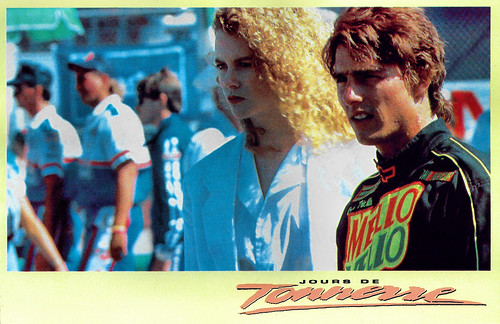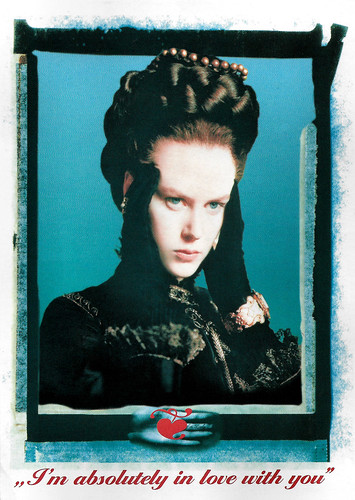
French postcard by Cart'com. Photo: Hugh Stewart. Nicole Kidman as Satine in Moulin Rouge (Baz Luhrmann, 2001).

Vintage press photo. Nicole Kidman in To Die For (Gus Van Sant, 1995).
Her first stage role was a bleating sheep
Nicole Mary Kidman was actually born in Honolulu, Hawaii, in 1967, while her Australian parents were there on educational visas. She is the daughter of Janelle Ann (Glenny), a nursing instructor, and Antony David Kidman, a biochemist, and clinical psychologist. Her younger sister is an Australian television personality, Antonia Kidman.
Shortly after her birth, the family moved to Washington, D.C., where Nicole's father pursued his research on breast cancer, and then. Three years later, the family made the pilgrimage back to her parents' native Sydney in Australia, where Nicole was raised. Young Nicole's first love was ballet, but she eventually took up mime and drama as well.
Her first stage role was a bleating sheep in an elementary school Christmas pageant. In her adolescent years, acting edged out the other arts and became a kind of refuge - as her classmates sought out fun in the sun, the fair-skinned Kidman retreated to dark rehearsal halls to practice her craft. She worked regularly at the Philip Street Theater, where she once received a personal letter of praise and encouragement from audience member Jane Campion, who was then a film student.
Kidman eventually dropped out of high school to pursue acting full-time. She broke into films at age 16, landing a role in the Australian holiday favorite Bush Christmas (Henri Safran, 1983). That appearance touched off a flurry of film and television offers, including a lead in the crime comedy BMX Bandits (Brian Trenchard-Smith, 1983) and a turn opposite Denholm Elliott and Hugo Weaving in the miniseries Bangkok Hilton (Ken Cameron, 1987).
The high-rated series was one of the last mini-series that attracted a large viewing audience and Kidman won her first Australian Film Institute Award. With the help of an American agent, she eventually made her US debut opposite Sam Neill and Billy Zane in the at-sea thriller Dead Calm (Phillip Noyce, 1989), filmed around the Great Barrier Reef.

French card by Universal International Pictures (part of a set of five cards on the film). Nicole Kidman and Tom Cruise in Days of Thunder (Tony Scott, 1990).

Belgian postcard by Boomerang Free Cards. Photo: Warner Bros. Nicole Kidman as Dr. Chase Meridian in Batman Forever (Joel Schumacher, 1995).
The kind of woman who pities us - because we aren't her
Nicole Kidman's next casting coup scored her more than exposure. While starring as a young doctor who falls in love with a NASCAR driver played by Tom Cruise in the racetrack romance Days of Thunder (Tony Scott, 1990), she won over the Hollywood hunk. The film was praised for its action sequences, its fast pace, Hans Zimmer's musical score, and the performances of Cruise and Kidman, and was among the highest-grossing films of the year.
After a whirlwind courtship, the couple wed in 1990. Determined not to let her new marital status overshadow her fledgling career, the actress pressed on. She appeared as a catty high school senior in the Australian coming-of-age comedy-drama Flirting (John Duigan, 1991), then as Dustin Hoffman's moll in the crime film Billy Bathgate (Robert Benton, 1991).
She reunited with Cruise for Far and Away (Ron Howard, 1992), the story of young Irish lovers who flee to America in the late 1800s, and she starred opposite Michael Keaton in the tear-tugger My Life (Bruce Joel Rubin, 1993). Despite her steady employment, critics and filmgoers still had not quite warmed to Kidman as a leading lady.
She tried to spice up her image by seducing Val Kilmer in Batman Forever (Joel Schumacher, 1995), but she achieved her real breakthrough with Gus Van Sant's critically acclaimed dark comedy To Die For (1995). She took home a Golden Globe and several critics' awards for the performance.
Roger Ebert: "the movie is about Suzanne, and Nicole Kidman's work here is inspired. Her clothes, her makeup, her hair, her speech, her manner, even the way she carries herself (as if aware of the eyes of millions) are all brought to a perfect pitch: Her Suzanne is so utterly absorbed in being herself that there is an eerie conviction, even in the comedy. She plays Suzanne as the kind of woman who pities us - because we aren't her, and you know what? We never will be."

Vintage press photo. Nicole Kidman and Matt Dillon in To Die For (Gus Van Sant, 1995).

Vintage press photo. Nicole Kidman in To Die For (Gus Van Sant, 1995).
A notoriously long, secretive shoot
In 1996, Nicole Kidman stepped into a corset to work with her countrywoman and onetime admirer, Jane Campion, on the adaptation of Henry James's The Portrait of a Lady (1996). A few months later, she tore across the screen in The Peacemaker (Mimi Leder, 1997), as White House nuclear expert Dr. Julia Kelly, opposite George Clooney. The latter film grossed US$110 million worldwide.
Kidman and Cruise then disappeared into a notoriously long, secretive shoot for Stanley Kubrick's final film, the sexual thriller Eyes Wide Shut (1999). They portrayed a Manhattan couple on a sexual odyssey. According to IMDb, it "prompted an increase in public speculation about their sex life (rumors had long been circulating that their marriage was a cover-up for Cruise's homosexuality). Tired of denying tabloid attacks, they successfully sued The Star for a story alleging that they needed a sex therapist to coach them through love scenes."
During her stay in England, Kidman also appeared in the play 'The Blue Room' (1998) on the West End. For her performance, she was awarded the Special Award at the London Evening Standard Theatre Awards, and in 1999, she was also nominated for a Laurence Olivier Theatre Award for Best Actress.
Family life has always been a priority for Kidman. Born to social activists (her mother was a feminist; her father, a labor advocate), Nicole and her little sister, Antonia Kidman, discussed current events around the dinner table and participated in their parents' campaigns by passing out pamphlets on street corners. When her mother was diagnosed with breast cancer, 17-year-old Nicole stopped working and took a massage course so that she could provide physical therapy (her mother eventually beat cancer).
Kidman and Cruise adopted two children: Isabella Jane (born 1993) and Connor Antony (born 1995). Despite their rock-solid image, the couple announced in early 2001 that they were separating due to career conflicts. Her marriage to Cruise ended mid-summer of 2001.

Dutch postcard by Boomerang Freecards, Amsterdam. Nicole Kidman in The Portrait of a Lady (Jane Campion, 1996). Captions: I'm absolutely in love with you (front). After 'The Piano' the new film by Jane Campion.

British postcard by Go Card. Photo: 20th Century Fox. Nicole Kidman as Satine in Moulin Rouge (Baz Luhrmann, 2001).
The face of Chanel No. 5
Nicole Kidman starred in the horror film The Others (Alejandro Amenábar, 2001), as Grace Stewart, a mother living in the Channel Islands during World War II who suspects her house is haunted. It grossed over US$210 million worldwide. That year, she also played one of her most successful roles as cabaret actress and courtesan Satine in the musical Moulin Rouge (Baz Luhrmann, 2001), opposite Ewan McGregor. For this role, she received her first Oscar nomination.
The following year, she won the Best Actress Oscar for The Hours (Stephen Daldry, 2002), which was based on Michael Cunningham's novel on author Virginia Woolf. Although naturally left-handed, she taught herself to write right-handed for her role in The Hours (2002), where she played the right-handed Woolf.
Nicole Kidman's later independent films often feature the theme of grief and sorrow, such as Lars von Trier's Dogville (2003), an experimental film set on a bare soundstage, the drama Birth (Jonathan Glazer, 2004), and the film adaptation of the Pulitzer Prize-winning play Rabbit Hole (John Cameron Mitchell, 2010).
She also portrayed upper-class women in epics, such as Ada Monroe in Cold Mountain (Anthony Minghella, 2003) opposite Jude Law and Renée Zellweger, Marisa Coulter in the fantasy adventure The Golden Compass (Chris Weitz, 2007), Lady Sarah Ashley in Australia (Baz Luhrmann, 2008), and Gertrude Bell in the autobiographical drama Queen of the Desert (Werner Herzog, 2015).
In conjunction with her success within the film industry, Kidman became the face of the Chanel No. 5 perfume brand. In 2006, she married country singer Keith Urban. They have two children. Kidman received her fourth Oscar nomination for Lion (Garth Davis, 2016). She portrayed Sue, the adoptive mother of Saroo Brierley (Dev Patel), an Indian boy who was separated from his birth family.
According to Susan Wloszczyna, Sue is "a tower of maternal tenderness and immense devotion embodied by Nicole Kidman, who is excellent despite a distractingly awful curly red wig. She uses the occasion to finally explain to Saroo exactly why she and his father, John (David Wenham, best known as Faramir in “The Lord of Rings”), decided to adopt him. Kidman, herself an adoptive mother of two, delivers her words with such nakedly honest emotion, all the Kleenex in the world won’t stop the ensuing flood."
Kidman played Martha Farnsworth, the headmistress of an all-girls school during the American Civil War, in Sofia Coppola's drama The Beguiled (2017), a remake of a 1971 film of the same name, which premiered at the Cannes Film Festival. She took on the supporting part of a rich socialite in the drama The Goldfinch (John Crowley, 2018), an adaptation of the novel by Donna Tartt.
She next starred alongside Charlize Theron and Margot Robbie in the drama Bombshell (Jay Roach, 2019), about sexual harassment at Fox News, in which she portrayed Gretchen Carlson. In 2020, Kidman's only film release was the musical comedy film The Prom (Ryan Murphy, 2020), based on the Broadway musical of the same name, which also starred Meryl Streep.

French postcard by Editions Mercuri, no. 1621. Photo: Warner Bros. Nicole Kidman as Dr. Chase Meridian in Batman Forever (Joel Schumacher, 1995).
Sources: Roger Ebert (Roger Ebert.com), Susan Wloszczyna (Rogert Ebert.com), Wikipedia (Dutch and English), and IMDb.
No comments:
Post a Comment